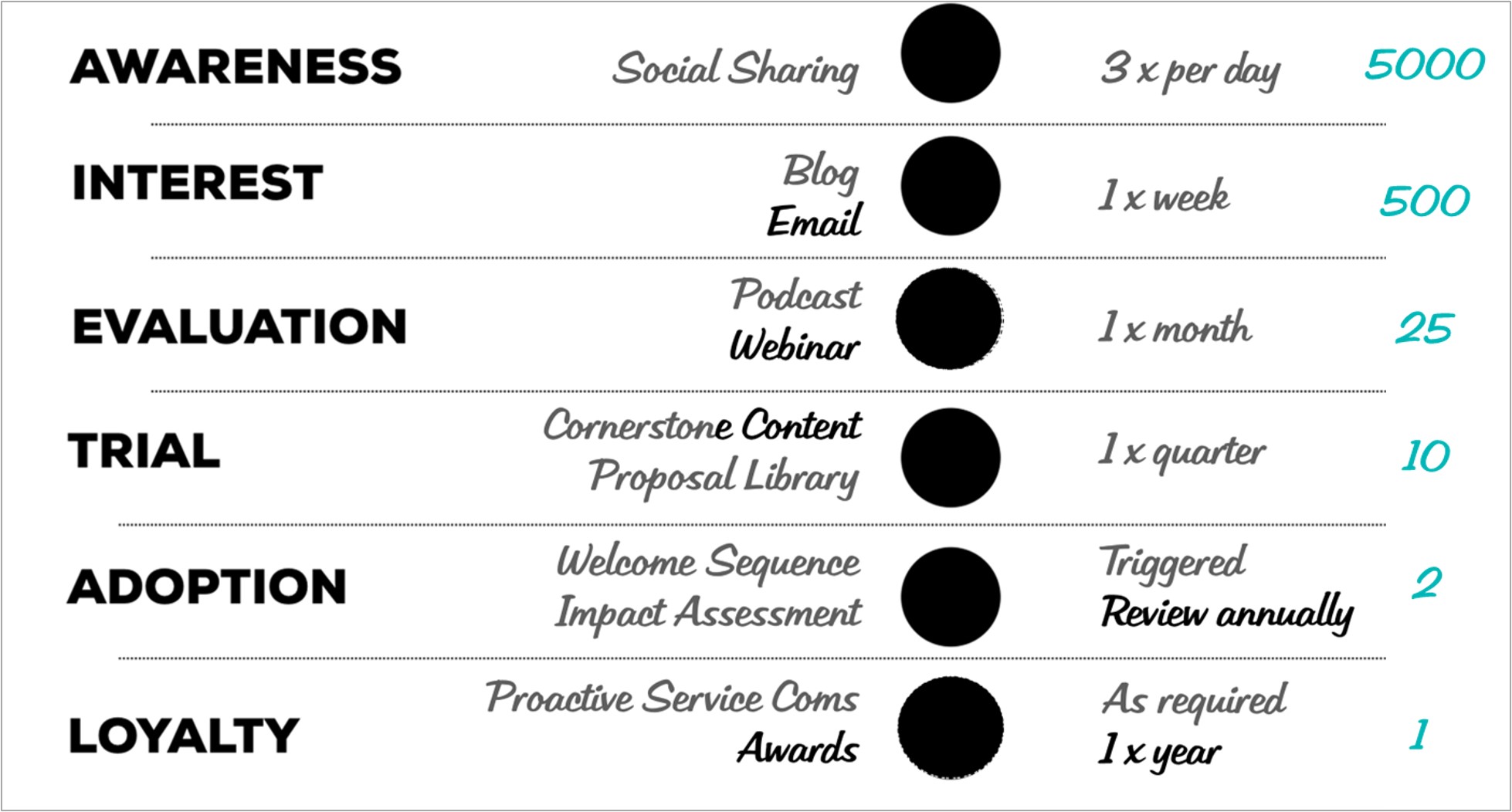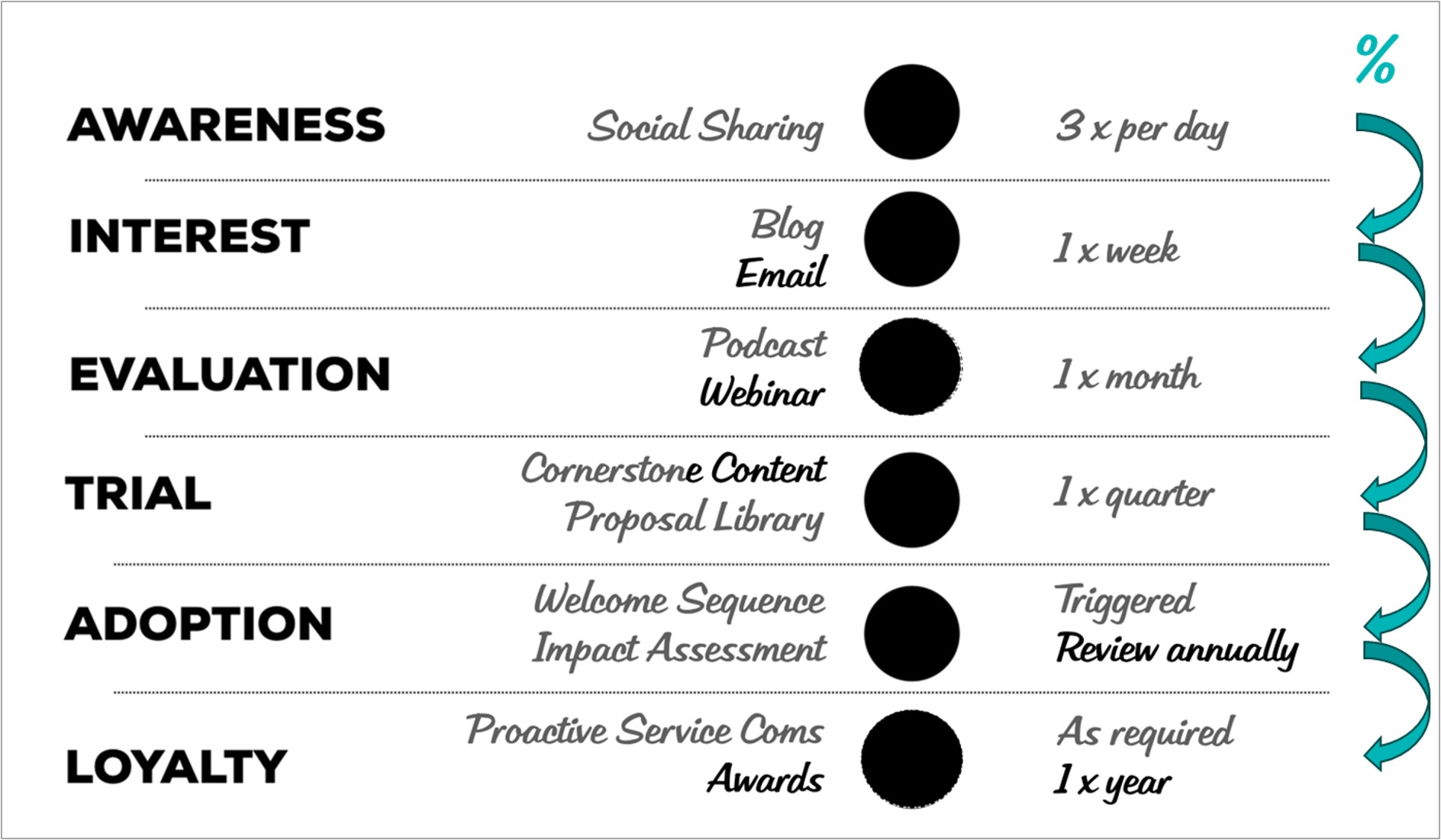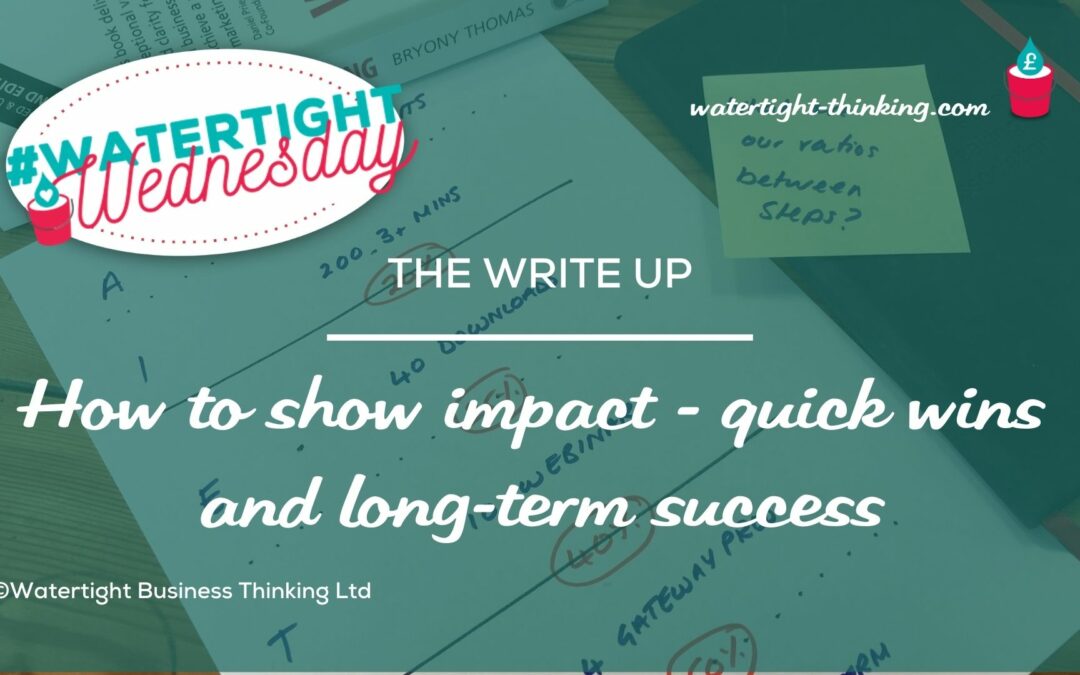Reading Time: 10 Minutes
“One thing is certain in a marketing role. You’ll want to show the impact marketing has – to the leadership team, board, stakeholders or the wider business. At this month’s roundtable we chatted about what quick wins you can show, what successes are longer term and what milestones you can put in place that will show progress.” ~ Rachael Wheatley, Managing Director | Watertight Business Thinking
Listen to the session podcast here
55-minute roundtable discussion on how to show impact – quick wins and long-term success
There’s often a tension between the demand for showing quick results and the longer-term nature of many marketing activities or projects. It can frequently feel like you need a magic wand, and unless you have this quick wins can seem impossible!
That balance between quick wins and long term successes and showing which are most relevant and why are part of a marketer’s skill set. And they’re different, depending on the context.
Campaigns are the easiest way to show quick wins
Campaigns are regular and last for short periods of time: days or weeks. If you’re selling an impulse buy, your quick wins could be numbers of clicks, engagement and even sales. If what you’re selling is a more considered purchase, sales (if that’s what people expect as quick wins) are nigh on impossible. The quick wins you’re looking for here will be whatever the next step is that you’ve put in front of your prospects: downloading a paper, signing up to an event, attending it.
Impact for campaigns might also be ratios, or conversion rates. That’s how many people go on to buy as a proportion of the number who clicked on an advert; or how many people attend an event as a proportion of those who registered. These ratios show people moving forward from one step to the next, and so are one way of showing the impact of your marketing.
You can look to improve volumes and ratios by changing one or more aspects of the marketing activity, which in turn will increase the outcome – usually sales for campaigns.
The impact of your baseline marketing plan
Campaigns are not the mainstay of your marketing plan. They’re in addition to it. The mainstay of your marketing plan are the activities that support your customer’s whole journey, from making them aware of you, to piquing their interest, on to them sussing and trying you out, and hopefully ending with them buying from you and becoming a loyal customer.
The rhythm of your marketing plan is different from campaigns. There’s a much more even pace to it, without the peaks you see for campaigns. What that means is that your quick wins will not be sales, if what you sell is a more considered purchase. Often you won’t see sales for months, so impact needs to be reframed in terms of progress, be that volume, ratios or milestones.
Volume as a measure of impact
These are things you can count. So early impact would be how many people view your LinkedIn post and go on to read your blog – these could be seen as the “quick wins”.

You can tweak and test your marketing to increase these volumes and therefore this impact.
Progress as a measure of impact
Impact can also be seen in the percentage of people who go from one step to the next. These ratios show the progress of a customer through the buying journey. If you want to increase the impact here, typical ways of doing this might be looking at: how to encourage people not just to read your blogs but delve deeper into related content or download a paper; or how to win more tenders you go for.

If you need to show impact from your marketing plan, quick wins will be the metrics that show volume and progress and longer term success will be about reaching that ultimate outcome. That outcome is usually sales, but it could be: more loyal customers, customers who buy more of your services or more subscription renewals, more referrals or reducing customer churn. Consider here what ‘success’ includes.
Because the quicker impact of your marketing plan isn’t necessarily sales, you need to manage expectations. It might be that others in the business are expecting results quickly (read: sales) and you’ll need to take them through why that’s not possible and identify where you do see the quick wins – volume and progress – both of which make that ultimate outcome more likely.
Bryony Thomas: I think there’s a correlation between volume being quantity and ratio being quality. Volume targets can easily be met by spending more money. Whereas ratios, the conversion between steps, are more determinant of the quality of your marketing; you see people progressing because they’re genuinely interested. You need to balance the desire for quick wins against the risk of shooting yourself in the foot because you’re lowering quality by increasing volume. Quick wins are fine, as long as they’re set in the context of quality goals. In fact, if you increase the ratios you don’t need to increase the volume and you’re still getting more quality prospects engaging with you.
Febronia Ruocco: The points you’re raising about how we review clicks on social media really needs to be looked at carefully, because we get a bit deluded by these likes, we get this dopamine hit. Even having 1000 subscribers to your newsletter may still result in zero sales. We need to be mindful of what we are measuring – is it reach, awareness, something else?
Bryony Thomas: Which is why bringing in ratios is so important. Everybody gets excited about volume. And actually how well your marketing is working and how good you are at your job is not shown in volume. It’s shown in ratios and conversions.
Rachael Wheatley: And the only way to get to ratios is to make sure you have a marketing supported sales process where you’re always inviting someone to the next step.
Luan Wise: Volume is something that comes up a lot for me in conversation – social media content that gets all the noise, the reactions. It can be really distracting for people. So I like your balance. You do need those milestones in place. For me, what really needs to be the focus of a social media post is something that moves people on. I’m not saying we shouldn’t still do those posts which get likes and lots of engagement but you do need activity that gets people to take those next steps.
Natasha Milsted: I work in the charity sector and quite often the things we’re measuring aren’t really the impact stuff we actually want to get to – i.e. an increased focus on health inequalities. We get stuck focusing on numbers of people at an event; we don’t always know how to demonstrate impact and how we’ve influenced people to change their behaviour. That could be because there isn’t a shared understanding internally of what impact our different products have on our target audience. And there’s not necessarily an easy way for us to track changes. It makes marketing more difficult: how can we promise we’re going to deliver something and a benefit to them, if we don’t know what that benefit is?
Bryony Thomas: I would remind people that you can set up impact assessments for things that appear subjective, e.g. how supported do you feel.
Rachael Wheatley: There’s a wider piece there, showing the impact of your product or service on your audience. You’d need to ask the questions: what is our impact, how do we measure that, how can we collate the data. Doing that can feed your marketing.
Febronia Ruocco: One thing that occurs to me as we’re talking is that your impact might appear low because you’re fishing in the wrong places. You need to be clear about your audience, how to communicate with them and where’s the best place to find them.
Paul Mills: One of the things to consider is how easy is it to actually measure the metrics. Because we don’t have accurate data all of the time, a lot of what we report is implied. If we’re seeing a high number of impressions, that must be a lot of people seeing the content and that must correlate to the uplift in sales. But really, it’s impossible to track everything and it’s easy to fall into the trap of reporting on the easy metrics, which don’t really tell the full story.
Amy Lauder: It’s interesting what’s being said about what you measure and what’s having an impact. When I first started, we weren’t doing a lot of marketing. It was really about doing the basics – telling people about website visits, social media impressions. Their faces glazed over because they didn’t know what that meant. As we got more sophisticated, and with a CRM in place, it’s become easier to see what does make the impact. An email sent to 100 people can have more impact. It is an issue for us because we have a long and complicated sales journey. It’s much harder to attribute impact so it’s interesting you’re talking about milestones. Especially seeing it from your stakeholders’ perspective and what they would consider impact and talking in their language. It could be, for instance, how we’ve influenced the industry – that could be more important to them than sales.
Bryony Thomas: Remember to associate those measures and activities to a step in the journey so you can at least orient people to the purpose of that activity. This helps to manage expectations, too.
How to show impact with strategic projects
These are longer-term by nature so success and impact needs to be framed within a longer time horizon. When we work with clients on 12 or 24 month transformation programmes or on strategic projects, they don’t see results for 9-12 months. That’s not to say you can’t show impact along the way, including quick(er) wins if you see these as progress towards the end goal.
Quick wins here can be achieved within weeks and are about reaching milestones. As you reach each milestone, you’re showing progress and therefore demonstrating the impact of that project or programme. It’s worth sharing your plan before you start, the picture of what things will be like when it’s completed and the milestones you’re setting out to achieve along the way. This manages expectations and shows that you need to reach those milestones to get the ultimate outcome you’re looking for.
Bryony Thomas: Impact is often sales driven but it’s worth having a think about impact in other areas such as confidence, comprehension. Set yourself a 10 point scale and ask where you are at the beginning of a project and then again at three, six months and a year.
Luan Wise: Milestones are important but sometimes within organisations you have different people involved in different milestones. They can be aware only of their bit and not understand the long term picture and impact as well.
Natasha Milsted: Building on that, not every company is starting from the same level playing field. There are a lot of things I’ve taken for granted when I’ve been in more mature organisations where it’s easier to find data. There’s definitely something around there not being best practice about how to do this stuff across the marketing profession. Also quite often we’re using this as a conversation to prove our worth rather than how the organisation is growing and having a wide impact. That probably comes from a place where marketing isn’t always valued.
Rachael Wheatley: I wonder if there’s an opportunity to connect the two – impact that leads to success of the business which therefore proves your worth. It’s easy for us to become defensive whereas we could be changing the conversation.
Febronia Ruocco: I was thinking about the proving your worth issue. A lot of what I do in strategic insight projects is testing the activation plan before it goes live to mitigate risk. If a campaign or piece of innovation bombs in the research we don’t launch. But the point of the exercise is to be iterative, not fail once and give up. The data is telling you bits need tweaking, but the financiers swoop in and say they won’t invest in the campaign rather than giving you time to work on and develop it.
Rachael Wheatley: I think there’s a chance even before the project starts to think about what the results might be and what criteria you’d use to review results. You’re getting ahead of them and pre-empting the response. So you could say, if this happens, we’ll tweak it and then review the data again.
Natasha Misted: I’ve seen that play out in two ways. Firstly where we cut the thing when actually we could have made it work, we just needed to take on board the learnings. Secondly, where the team was too scared to admit they’d failed because they saw it as a personal reflection on them.
Watertight Wisdom
What’s worked for us
Eight nuggets from around the room:
- Stay focused on what you are looking to achieve. Keep the end in mind, and use volume, ratios and milestones to show progress.
- Link your marketing activities and measurements to a phase of the journey. It’s much easier to show impact of marketing.
- Set the expectations at the beginning. It helps people not to fixate on quick wins being only about quick sales, which is not always possible.
- Be clear about why. This links to knowing – and therefore being able to show – what job each marketing activity performs and the impact you want it to achieve.
- Pre-alignment with commercials. Makes it easier to show that your marketing is helping to achieve business success.
- Take the time to answer the question “so what?”. Align everyone at the start of the project as to what you’re measuring and why.
- Never measure metrics for the sake of it or to just to prove your worth. Change the conversation so impact becomes about business success.
- Think in terms of milestones rather than always metrics.
What would you add to our list? Do let us know your thoughts.
To join the conversation at our next Watertight Wednesday marketing roundtable in June sign up here. We’ll be having a chin-wag about what makes for a good marketing leader. What qualities you’ll need, what the role entails and how to make sure you’re both successful and motivated.
Do come along and share your experience with others and tap into ideas from the room about how to achieve success.

Rachael Wheatley
Managing Director, Watertight Thinking
Rachael brings over 30 years’ of marketing experience, with a particular focus on building and developing effective marketing teams that are able to act as a strategic driving force across an organisation. She has worked with Watertight since 2014 as a Master Practitioner and joined the business as MD in 2022.



